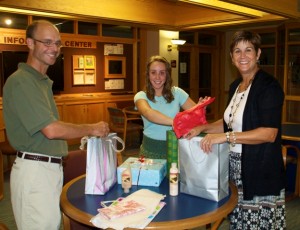
Professor Chris Ruebeck, Rachel Ingber '11 , and Nancy Dy, supervisor with Nurse Family Partnership
Buying a holiday gift for someone you know is hard enough, but when the recipient is a stranger with a new baby, it can become a real challenge.
Just ask Rachel Ingber ’11 (Lafayette Hill, Pa.), who runs the Holiday Helpers program through the College’s Landis Community Outreach Center. Each year, students work with the local Nurse Family Partnership to provide presents to about 160 first-time moms in need and their children.
“Sometimes a mom would ask for a sweater or a pair of jeans but there’s no guarantee they’d like them, so when the nurse came to visit it would be shoved in a corner,” says Ingber, a mathematics-economics major, who loves watching people open gifts she hand picks for them. “The donor was wasting their money because the gift wasn’t being used.”
This didn’t make good financial sense to Ingber, so when it came time to choose a senior honors thesis, she decided to examine the economic efficiencies of gift giving with an eye on making the experience satisfying for both giver and receiver.
Before she began, her adviser, Chris Ruebeck, associate professor of economics, suggested she read Scroogenomics by economist Joel Waldfogel, who argues that the value of a gift is only as great as the recipient’s appreciation. In economic terms it’s called “deadweight loss,” and it goes something like this: Say your grandmother buys you a Lehigh sweatshirt for $50. You clearly will never wear it, so the deadweight loss is the full value of the item, or $50. If she had bought you a more appropriate sweatshirt for $50, but one you would have only paid $30 for, then the deadweight loss is $20.
Waldfogel, who interviewed economics majors at Yale University for his study, believes gift cards bring the most joy because the recipient can buy what they want. That way, the value of the item to the recipient is the same or greater than the purchase price.
But not everyone agrees. “There’s a resistance to gift cards because they don’t feel as thoughtful,” says Ruebeck, citing other scholars’ interviews of students at Harvard School of Public Health.
Whether that applies to anonymous gift-giving as a form of charity remains to be seen. “One facet of Rachel’s thesis that distinguishes this study from the existing literature is that she’s considering the gift preferences of a socio-economic group that’s not been studied before,” says Ruebeck. “It will be interesting to compare findings.”
Recently, Ingber was very busy collecting donations for clients of the Nurse Family Partnership. A couple weeks ago the Landis Center looked like the North Pole, overflowing with colorful packages containing toys, games, and books for the children. In addition, each mother is receiving a $25 gift card to either Wal-Mart or Target and a few small personal gifts.
Now that the gifts have been distributed, Ingber will survey the women’s satisfaction with them and the outcome will provide insight into gift giving, charity, and deadweight loss. The results may also determine the direction the Nurse Family Partnership will take in spreading holiday cheer. Will it up the dollar amount of gift cards or try harder to match the preferences of its clients with donor gifts?
“We want to improve their lives, but still make the holiday meaningful,” says Ingber.
And what about the rest of us, who struggle each year trying to find that perfect gift for a loved one that conveys both thoughtfulness and deep affection? Should we, too, abandon our gift-giving odysseys for the convenience and guaranteed value of plastic?
That, says Ingber, is someone else’s senior thesis.

1 Comment
Comments are closed.